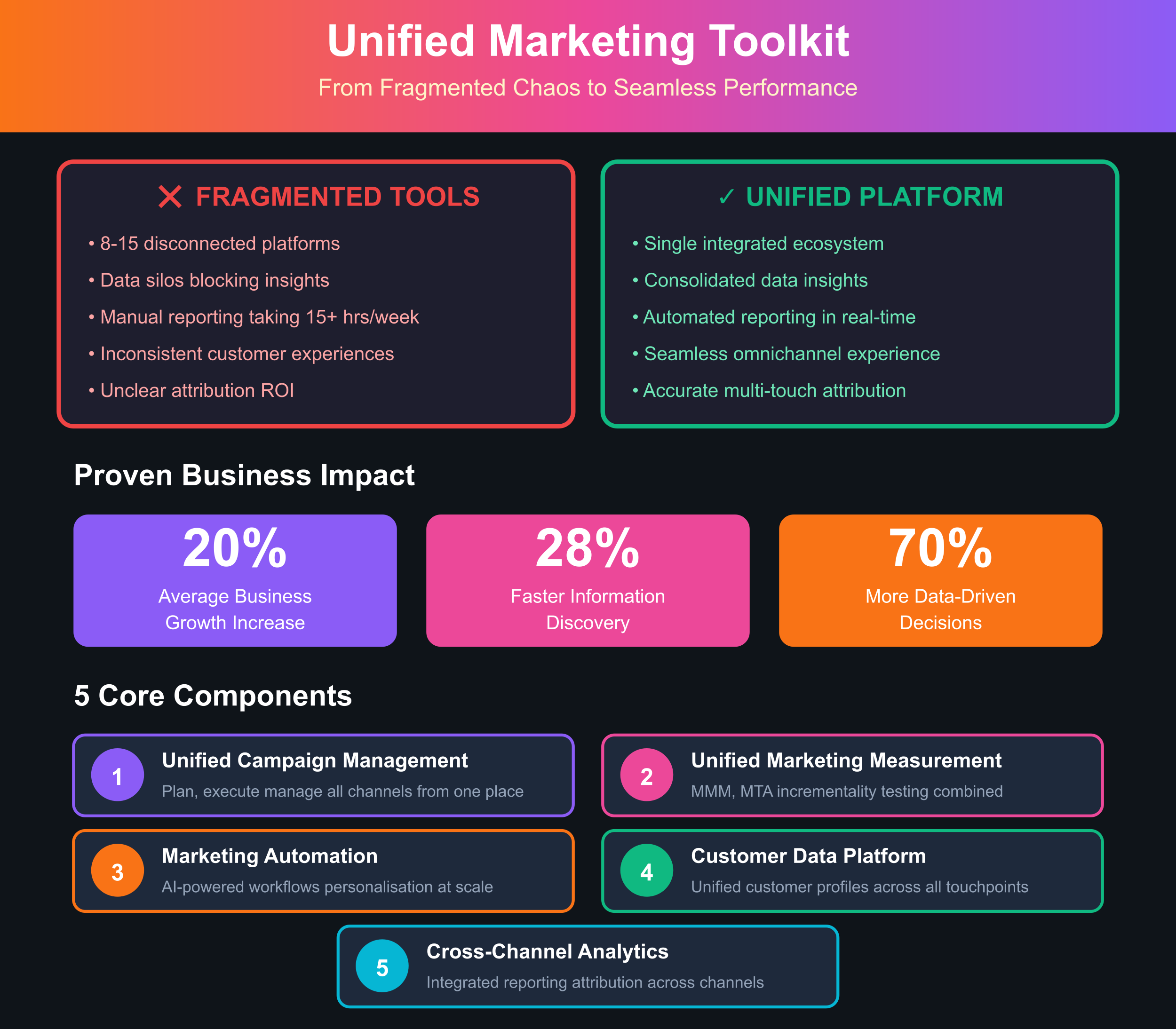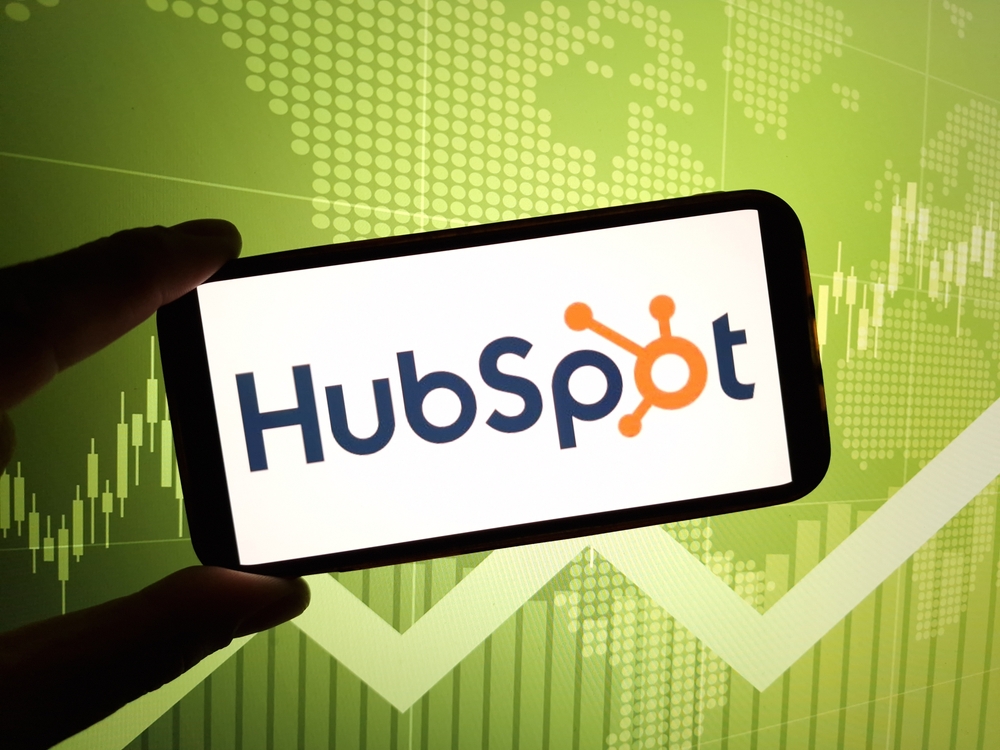
Quick Answer: What Are Unified Marketing Toolkits and Why Do They Matter?
Unified marketing toolkits are software solutions that consolidate various marketing activities—campaign creation, execution, automation, personalisation, and measurement—into single platforms, replacing fragmented point solutions that create data silos and workflow inefficiencies. These all-in-one platforms bring together different tools and customer data, enabling marketers to build, launch, automate, optimise, and analyse efforts across all channels from single places. The business impact is measurable: companies using advanced visualisation platforms within unified systems report average 20% increases in business growth, with adoption growing approximately 65%, whilst businesses using interactive tools within these platforms are 28% more likely to find information quicker than those relying on static dashboards and 70% more likely to make data-driven decisions. For Australian businesses specifically, unified toolkits solve critical challenges including eliminating disconnected tool management (reducing total cost of ownership), providing accurate marketing ROI calculations through consolidated data, enabling seamless collaboration across distributed teams, and delivering consistent customer experiences across all touchpoints. Key capabilities include end-to-end campaign management from planning through execution to analysis, marketing mix modeling (MMM) and multi-touch attribution (MTA) for accurate performance measurement, AI-powered automation handling repetitive tasks whilst maintaining strategic human control, and cross-channel integration spanning email, social media, paid advertising, SMS, web personalisation, and offline channels. In today's fragmented digital landscape where marketers juggle dozens of tools across advertising, email, social media, and analytics, unified platforms bring cohesion, clarity, and control to marketing operations by consolidating campaign management, measurement, automation, and customer data into single ecosystems that streamline workflows, improve ROI visibility, and deliver consistent customer experiences across channels.
Key Takeaways: Unified Marketing Toolkit Strategies for Australian Businesses
The Fragmentation Problem Costing Australian Businesses: Australian marketing teams typically manage 8-15 separate tools covering social media scheduling, email marketing, paid advertising, analytics, CRM, content management, automation, and reporting. This fragmentation creates data silos preventing holistic performance views, workflow inefficiencies from switching between platforms, inconsistent customer experiences across touchpoints, delayed decision-making waiting for manual data compilation, budget waste from overlapping capabilities and redundant subscriptions, and team burnout from managing too many interfaces, credentials, and contracts. Research indicates 56% of marketing managers reported feeling overwhelmed and burned out during 2024, with many attributing it to massive pressure managing multiple digital marketing tools and software. The fragmented approach leads to misaligned teams and blurry performance views that undermine marketing effectiveness despite significant tool investments.
Core Components of Effective Unified Toolkits:
- Unified Campaign Management: Centralised systems enabling marketers to plan, create, execute, and manage multichannel campaigns (email, social, ads, web, SMS) from single interfaces with built-in governance, visibility, and control across regions, functions, and agencies
- Unified Marketing Measurement (UMM): Consolidation of marketing performance data from all channels applying combination of measurement methodologies—Marketing Mix Modeling, Multi-Touch Attribution, Incrementality Testing, and Causal Attribution—providing comprehensive views of marketing effectiveness beyond last-click attribution
- Marketing Automation: AI-powered systems handling repetitive tasks including lead scoring, email sequences, social posting schedules, ad bid optimisations, and personalisation at scale whilst maintaining human strategic oversight
- Customer Data Platform (CDP): Unified customer data aggregation from all touchpoints creating single customer views enabling sophisticated segmentation, personalisation, and journey orchestration
- Cross-Channel Analytics: Integrated reporting showing performance across all channels simultaneously, revealing attribution patterns, identifying optimization opportunities, and calculating accurate ROI

Platform Selection for Australian Business Contexts: For enterprises requiring sophisticated capabilities: Salesforce Marketing Cloud offers end-to-end campaign management with deep CRM integration (though lacks true unified measurement), Sprinklr Marketing unifies planning, content creation, publishing, and analytics elevated by AI, and Adobe Experience Cloud provides comprehensive tools but requires technical expertise. For growing businesses seeking balance: HubSpot Marketing Hub combines CRM, email, campaigns, automation, and content tools in user-friendly platforms supporting inbound strategies with seamless sales/service integration. For SMEs prioritising affordability and ease: platforms like Insider offer data unification, broad channel support, advanced personalisation, cross-channel journey building, and built-in A/B testing with quality support. Australian businesses should evaluate based on integration capabilities with existing tech stacks (Salesforce, Shopify, Meta Ads), onboarding support and documentation quality, scalability accommodating growth without platform migrations, and pricing structures fitting SME budgets versus enterprise investments.
Implementation Strategies for Maximum ROI: Successful unified toolkit adoption requires phased implementation rather than attempting comprehensive transformation simultaneously. Start by auditing current tool landscape identifying redundancies, gaps, and pain points. Define clear integration priorities addressing immediate business needs—typically campaign management and analytics first, followed by automation and personalisation. Establish data governance ensuring quality, consistency, and compliance before migrating to unified systems. Train teams not just on technical operation but strategic thinking leveraging unified capabilities. Monitor adoption rates and user satisfaction adjusting implementation based on feedback. Australian businesses benefit from choosing platforms understanding local market nuances, complying with Australian data regulations, supporting local payment methods and AUD pricing, and offering timezone-appropriate support. The goal isn't tool consolidation for its own sake—it's workflow simplification, data unification, and performance improvement that unified toolkits enable when implemented strategically.

The Fragmentation Crisis: Why Disconnected Tools Fail Modern Marketing
Walk into any Australian marketing department and you'll find teams drowning in tools. Social media managers toggle between Hootsuite, Buffer, and native platform interfaces. Email marketers work in Mailchimp or Campaign Monitor. Paid advertising specialists live in Google Ads, Facebook Ads Manager, and LinkedIn Campaign Manager. Analytics teams extract data from Google Analytics, Adobe Analytics, and platform-specific dashboards. Content managers operate in WordPress, various DAM systems, and collaboration platforms. CRM teams work in Salesforce, HubSpot, or local solutions.
Each tool promises to solve specific problems. Together, they create bigger ones. Data lives in silos, preventing holistic views of customer journeys or campaign performance. Insights from email campaigns don't inform social media strategy. Paid advertising data doesn't connect to organic content performance. Website behaviour remains disconnected from CRM customer profiles. This fragmentation creates what industry analysts call "the MarTech Paradox"—more tools than ever, yet less clarity about what's actually working.
In today's fragmented digital landscape, marketers juggle dozens of tools across advertising, email, social media, analytics, and more. This disjointed approach often leads to data silos, misaligned teams, and blurry views of performance. That's where unified marketing platforms come in—modern solutions designed to bring cohesion, clarity, and control to marketing operations.
For Australian businesses, fragmentation carries specific costs beyond general inefficiency. Consider an SME running campaigns across Google, Meta, Instagram, LinkedIn, and email whilst managing customer data in separate CRM, tracking website behaviour in Google Analytics, and attempting to measure ROI by manually compiling data from multiple sources into spreadsheets. Each platform reports success using different attribution models and metrics. Google Ads claims credit for conversions via last-click attribution. Facebook attributes conversions to any user who saw ads within attribution windows. Email platform credits opens and clicks. CRM tracks sales but doesn't connect them to specific marketing touchpoints.
The marketing team faces impossible questions: Which channel actually drives results? Where should budget increase? What messaging resonates? Which customer segments convert best? Without unified data, answers require guesswork wrapped in sophisticated-sounding justifications. Meanwhile, competitors using unified toolkits make decisions based on comprehensive attribution, real-time performance data, and holistic customer views.
The workflow implications compound data problems. Marketers spend hours jumping between platforms, copying data, reconciling conflicts, and creating reports for stakeholders who increasingly question marketing's business impact. Juggling all of these tasks successfully depends on having versatile, robust, and user-friendly tools. Unfortunately, that's exactly what fragmented point solutions fail to provide.
Australian businesses can't afford this inefficiency. With marketing budgets under scrutiny, particularly in economically uncertain periods, demonstrating clear ROI becomes essential. Unified toolkits transform marketing from cost centres with unclear value to revenue drivers with measurable impact—but only when implemented strategically rather than simply adding another platform to already overcrowded tech stacks.
Understanding Unified Marketing Platforms: Core Components
Before exploring specific platforms and implementation strategies, understanding what actually makes marketing toolkits "unified" clarifies which capabilities matter versus which features represent marketing fluff disconnected from business value.
Unified Campaign Management: Planning to Execution
A Unified Campaign Management Platform is centralised system that enables marketers to plan, create, execute, and manage multichannel marketing campaigns (e.g., email, social, ads, web, SMS) from single interfaces. This consolidation eliminates workflow friction from constantly switching between platforms whilst ensuring brand consistency and strategic alignment across channels.
Effective unified campaign management includes centralised content libraries storing all marketing assets—images, videos, copy, templates—accessible across campaigns and channels with version control and approval workflows; cross-channel orchestration enabling marketers to coordinate email, social, paid advertising, and website experiences as integrated campaigns rather than isolated tactics; collaborative planning tools supporting distributed teams working together on campaign strategies, creative development, and execution timelines; automated publishing and scheduling ensuring content deploys across channels at optimal times without manual intervention; and integrated approval workflows routing campaign elements through appropriate stakeholders before deployment, maintaining brand standards and regulatory compliance.
For Australian businesses managing campaigns across multiple regions, languages, or franchises, unified campaign management prevents the chaos of disconnected execution whilst maintaining local relevance within global brand guidelines. A retail brand might create national campaigns in central platform then enable regional managers to customise messaging, imagery, and offers for local markets—all within guardrails ensuring brand consistency.
The value proposition centres on speed and coordination. Traditional fragmented approaches require separate briefing, creative development, and deployment for each channel. Unified management enables "create once, deploy everywhere" workflows that dramatically reduce time-to-market whilst ensuring consistent customer experiences regardless of touchpoint.
Unified Marketing Measurement (UMM): Beyond Last-Click Attribution

Unified Marketing Measurement (UMM) solves challenges by integrating data from all marketing channels, including digital, offline, paid, owned, and earned, into single consolidated views. This unified data enables marketers to measure, analyse, forecast, and optimise marketing activities across channels, ultimately leading to smarter budget allocation and improved ROAS.
Traditional attribution models—last-click, first-click, linear—fail to capture complex modern customer journeys. Research shows 41% of marketers still use last-touch attribution, 44% rely on first-touch attribution, with 21% depending solely on single-channel attribution models. These outdated methods fail to capture full scope of customer journeys in multi-touchpoint environments.
UMM combines multiple methodologies providing comprehensive performance views:
Marketing Mix Modeling (MMM): Statistical techniques analysing historical data—clicks, impressions, spend, seasonality, external factors—measuring various marketing activities' impacts on sales or KPIs. MMM excels at understanding broad channel performance and long-term trends but operates at aggregate levels missing individual customer insights.
Multi-Touch Attribution (MTA): Tracking individual customer journeys across touchpoints, assigning credit to each interaction based on influence. MTA provides granular insights into specific campaign and creative effectiveness but requires extensive tracking often complicated by privacy regulations and cross-device behaviour.
Incrementality Testing: Controlled experiments measuring whether marketing activities cause additional conversions beyond what would occur naturally. Hold-out groups not exposed to campaigns provide baselines for calculating true incremental impact, revealing whether channels drive new behaviour or simply capture credit for conversions that would happen anyway.
Causal Attribution: Advanced statistical techniques identifying cause-and-effect relationships between marketing activities and outcomes, distinguishing genuine influence from correlation. If Google Search conversions spike following TV campaigns, causal attribution determines whether TV actually drove search behaviour or whether both increased due to external factors like seasonality.
These triangulated marketing methodologies combine to form Unified Marketing Measurement platforms, integrating historical and real-time data from paid and organic campaigns across online and offline channels, delivering single, consolidated views enabling accurate performance measurement.
For Australian businesses, UMM addresses critical questions: How much do brand campaigns contribute to performance campaign results? Which offline touchpoints (TV, radio, out-of-home) drive online conversions? What's the true ROI of influencer partnerships when measured against alternatives? How do channels interact—does Instagram advertising amplify Google Search performance or cannibalise it?
These insights transform budget allocation from guesswork to data-driven strategy, potentially improving ROAS by 20-50% through optimal channel mix rather than over-investing in last-click winners that get disproportionate credit.
Marketing Automation: Scaling Personalisation Without Sacrificing Strategy
Marketing automation within unified platforms streamlines marketing efforts, automates tasks, and improves overall productivity, allowing for better decision-making. However, automation must serve strategic objectives rather than becoming ends themselves—automated mediocrity executes faster but delivers worse outcomes than thoughtful manual approaches.
Effective automation within unified toolkits includes lead scoring and nurturing automatically identifying high-value prospects based on behaviour, demographics, and engagement, then delivering personalised content sequences moving them through funnels; email marketing automation triggered by specific behaviours or timeline events, delivering relevant messages at optimal moments without manual intervention; social media scheduling and publishing maintaining consistent presence across platforms whilst optimising posting times for maximum engagement; ad campaign optimisation using AI to adjust bids, budgets, and targeting based on performance data, maximising ROI within defined parameters; and personalisation engines dynamically adjusting website content, product recommendations, and messaging based on individual visitor attributes and behaviour.
Australian businesses benefit particularly from automation handling time-consuming repetitive tasks—email sends, social posts, reporting generation—freeing teams to focus on strategy, creative development, and relationship building that genuinely require human judgment.
However, automation risks include set-it-and-forget-it mentality where automated processes run without oversight, potentially sending irrelevant messages, wasting budget on underperforming tactics, or missing opportunities requiring human intervention. Over-automation creating robotic, impersonal experiences that alienate customers seeking genuine connections. Automation without strategy executing tactical tasks efficiently whilst pursuing wrong objectives altogether.
The solution involves treating automation as amplifiers of human strategy rather than replacements. Define clear strategies, then automate execution. Monitor automated processes regularly, adjusting based on performance. Maintain human touchpoints where relationships matter most—complex sales, customer service escalations, high-value accounts. Use automation to scale personalisation that would be impossible manually, not to eliminate personal touches customers value.
Customer Data Platforms: The Foundation of Unified Marketing

Customer Data Platforms aggregate data from all customer touchpoints—website visits, email interactions, purchase history, customer service contacts, social media engagement, in-store behaviour—creating unified customer profiles enabling sophisticated segmentation, personalisation, and journey orchestration.
Within unified marketing toolkits, CDPs serve as foundational data layers feeding all other capabilities. Campaign management accesses customer data for targeting. Automation uses profiles for personalisation. Analytics leverage unified data for attribution and performance measurement. Without quality CDP foundations, other unified capabilities operate with incomplete or inaccurate customer understanding.
Effective CDPs within Australian business contexts must handle data quality and governance ensuring information accuracy, completeness, and compliance with Australian privacy regulations; identity resolution matching customer interactions across devices, channels, and touchpoints despite cookies, different email addresses, or offline-to-online journeys; real-time data processing updating customer profiles instantly as new interactions occur, enabling immediate personalisation and automation responses; segmentation capabilities creating targeted audiences based on combinations of demographic, behavioural, and predicted attributes; and activation enabling easy audience deployment to advertising platforms, email systems, personalisation engines, and other marketing tools.
For Australian businesses, CDP implementation often represents biggest hurdle in unified toolkit adoption. Customer data frequently lives in disparate systems—e-commerce platforms, POS systems, CRM databases, loyalty programmes—each with different formats, quality levels, and access restrictions. Unifying this data requires technical integration, data cleansing, governance frameworks, and ongoing maintenance that smaller businesses struggle to resource adequately.
However, CDP value justifies investment. Brands leveraging unified customer data report more accurate marketing ROI calculations, maximisation of marketing budgets through reduced tool redundancy, and easier maintenance and long-term management compared to juggling multiple point solutions with disconnected customer views.
Platform Landscape: Choosing Right Unified Toolkit for Your Business
The unified marketing platform market offers diverse solutions tailored to different business sizes, industries, and sophistication levels. Understanding landscape options enables Australian businesses to select platforms matching specific needs rather than defaulting to biggest names or cheapest options.
Enterprise-Grade: Salesforce Marketing Cloud
Salesforce dominates enterprise marketing technology through comprehensive capabilities spanning email marketing (Email Studio), mobile messaging (Mobile Studio), social media management (Social Studio), advertising (Advertising Studio), web personalisation (Personalisation Builder), and customer journey orchestration (Journey Builder). Integration with Salesforce CRM creates powerful alignment between marketing and sales teams, enabling closed-loop reporting from campaign execution through lead generation to revenue attribution.
For Australian enterprises already invested in Salesforce ecosystems, Marketing Cloud represents logical unified platform choice. However, implementation complexity and cost place it beyond reach for most SMEs. Platform sophistication requires dedicated administrators and potentially external consultants for configuration and ongoing management. Pricing typically starts AU$50,000+ annually making it enterprise-only investment.
Critical limitation: while Marketing Cloud offers reporting and analytics via Marketing Cloud Intelligence (formerly Datorama), it does not provide MMM, MTA, or incrementality testing capabilities found in dedicated measurement platforms. Enterprises requiring true unified measurement often supplement Salesforce with specialised UMM platforms like Lifesight or Measured.
Mid-Market: HubSpot Marketing Hub

HubSpot's strength lies in accessibility—sophisticated capabilities wrapped in intuitive interfaces requiring minimal technical expertise. The platform grew from blogging and email roots to comprehensive marketing automation covering SEO, social media, landing pages, forms, workflows, reporting, and attribution. Tight integration between Marketing Hub, Sales Hub, and Service Hub creates unified customer experience platform managing entire lifecycle from anonymous visitor through customer to advocate.
For Australian SMEs and mid-market companies, HubSpot offers enterprise-grade capabilities without enterprise complexity or cost. Pricing starts around AU$1,000-2,000/month for Professional tier providing most functionality growing businesses need, scaling to AU$5,000+/month for Enterprise tier with advanced features and support.
HubSpot particularly suits businesses embracing inbound methodology—attracting customers through valuable content rather than interruptive advertising. Built-in SEO recommendations, blog publishing, content strategy tools, and social media integration support content-led growth strategies that resonate with Australian consumers increasingly skeptical of traditional advertising.
Limitations include less sophisticated paid advertising management compared to specialised platforms, limited offline marketing capabilities for businesses running substantial traditional media, and customization restrictions compared to enterprise platforms offering greater flexibility at cost of complexity.
Specialised: Unified Measurement Platforms
For businesses requiring sophisticated marketing measurement beyond what campaign management platforms provide, specialised UMM platforms offer advanced analytics without replacing existing campaign execution tools.
Lifesight: Leading unified measurement platform in 2025, Lifesight combines Marketing Mix Modeling, Multi-Touch Attribution, Incrementality Testing, and Causal Attribution providing comprehensive views of marketing effectiveness across channels. Platform excels at identifying true causal impact of marketing activities, enabling optimal budget allocation based on data rather than attribution bias. Pricing starts AU$7,000+/month positioning it for mid-market and enterprise budgets.
Measured: Combines MMM and MTA hybrid methodologies analysing both macro and micro-level data providing balanced perspectives on campaign performance. Particularly strong for businesses running both brand-building and performance marketing campaigns requiring understanding of how activities across funnel interact and reinforce each other.
These platforms integrate with existing campaign management tools—extracting data from advertising platforms, analytics systems, CRM databases—then applying advanced measurement methodologies revealing insights individual platforms miss. For Australian businesses already using HubSpot, Salesforce, or other campaign platforms but lacking confidence in attribution accuracy, adding specialised UMM platform fills critical measurement gap without replacing functional campaign tools.
All-in-One: Insider
Insider offers data unification and segmentation, broad channel support, advanced personalisation across all touchpoints, cross-channel journey building and marketing automation, built-in A/B testing and feedback tools, ease of use, quality customer support, and fast time-to-value, making it comprehensive unified platform for mid-market and enterprise businesses seeking single solution consolidating multiple point tools.
Platform handles website personalisation, mobile app engagement, email marketing, SMS campaigns, WhatsApp marketing, push notifications, and cross-channel orchestration—all feeding from unified customer data platform and controlled through single interface. This breadth enables businesses to manage entire digital marketing ecosystem from one platform rather than juggling multiple specialised tools.
For Australian businesses, Insider represents middle ground between accessibility (more approachable than Salesforce) and capability (more comprehensive than basic tools), with pricing and support structures accommodating both growing mid-market companies and established enterprises.
Emerging: Amazon Campaign Manager
At 2025 unBoxed conference, Amazon Ads introduced new AI-powered unified Campaign Manager enabling advertisers to manage all parts of marketing funnels in coordinated setups. Once campaigns go live, systems automatically adjust budgets, audiences, and tactics based on performance data, managing all funnel stages simultaneously.
For businesses heavily invested in Amazon ecosystem—whether selling through Amazon marketplace or advertising on Amazon properties—unified Campaign Manager streamlines previously fragmented campaign management across Sponsored Products, Sponsored Brands, and Streaming TV formats. AI-powered Full-funnel Campaigns provide recommendations on reaching customers across all channels with automated optimisation reducing manual management time.
Australian businesses should monitor Amazon's platform evolution particularly if significant portions of sales or advertising occur through Amazon channels. However, platform remains Amazon-specific rather than true omnichannel solution managing campaigns across Google, Meta, LinkedIn, and other platforms alongside Amazon properties.
Implementation Strategy: From Fragmented Chaos to Unified Clarity

Selecting appropriate unified platform represents only first step. Successful implementation—transforming fragmented tool chaos into streamlined unified operations—requires systematic approach balancing technical integration, organisational change management, and strategic alignment.
Phase 1: Audit Current State and Define Requirements
Begin by comprehensively documenting existing tool landscape. Create spreadsheet listing every marketing tool currently used including purpose served, who uses it, monthly/annual cost, integrations with other tools, pain points and limitations, and whether capabilities overlap with other tools. This audit typically reveals shocking reality: businesses paying for overlapping capabilities across multiple tools, tools purchased but barely used, critical gaps despite numerous tool subscriptions, and data scattered across platforms preventing holistic analysis.
For Australian marketing teams, audit often uncovers 10-15 separate tools with combined costs of AU$50,000-200,000+ annually for mid-sized operations. Significant portions of these costs fund redundant capabilities or tools delivering minimal value.
Define unified platform requirements based on audit findings and business objectives. Requirements should address immediate pain points (What problems must unified platform solve?), strategic capabilities (What future capabilities enable planned growth?), integration needs (Which existing tools/systems must connect?), and team skills (What complexity levels can current team manage?).
Australian businesses should particularly consider local requirements: integration with Australian payment gateways, compliance with Australian privacy regulations, support for AUD pricing and Australian tax structures, understanding of Australian market dynamics and consumer behaviour, and vendor support availability in Australian timezones.
Phase 2: Select Platform and Plan Migration
With requirements defined, evaluate platforms systematically rather than defaulting to biggest brands or accepting vendor sales pitches uncritically. Request demos focusing on your specific use cases rather than generic feature tours. Test platforms with trial periods or pilots running actual campaigns. Speak with current customers in similar industries and company sizes. Calculate total cost of ownership including subscription fees, implementation costs, ongoing management time, and training investments.
For Australian businesses, vendor selection should prioritise local presence or strong Australian customer bases demonstrating understanding of local market, availability of local currency pricing without punitive exchange rate markups, quality of support during Australian business hours rather than requiring engagement with overseas teams in mismatched timezones, and compliance infrastructure supporting Australian regulatory requirements.
Migration planning addresses technical data integration, workflow transition, and team training. Most businesses adopt phased approaches rather than attempting immediate comprehensive migrations. Common sequences begin with campaign management and analytics (enabling immediate performance visibility), expand to marketing automation (delivering quick wins through automated workflows), add personalisation capabilities (improving customer experiences), and finally implement advanced features like AI-powered recommendations or predictive analytics once foundations stabilise.
Phase 3: Integrate Data and Establish Governance
The more tools you're using, the higher their cost—both in terms of money and effort. Consolidating stack into as few solutions as possible lets you reduce total cost of ownership and work much more efficiently. However, consolidation only delivers value when data flows cleanly between systems and maintains quality standards.
Data integration typically represents biggest implementation challenge. Customer information lives in CRM systems, purchase history resides in e-commerce platforms, email engagement data sits in email service providers, website behaviour tracks in analytics platforms, and paid advertising performance reports from ad platforms. Unified platforms require importing, mapping, and synchronising this data—often revealing quality issues, duplicate records, and conflicting information requiring resolution.
Establish data governance frameworks before migration defining data quality standards, ownership and accountability structures, privacy and security protocols, integration schedules and refresh frequencies, and incident response procedures for data issues. For Australian businesses, governance must explicitly address Privacy Act compliance particularly regarding customer data collection, storage, usage, and retention.
Quality governance prevents unified platforms from becoming unified messes—centralising poor-quality data that undermines insights rather than enabling them. Investment in data cleaning, de-duplication, and standardisation before migration pays dividends through accurate attribution, reliable reporting, and effective personalisation downstream.
Phase 4: Train Teams and Drive Adoption
Even perfectly configured unified platforms fail when teams don't adopt them. Successful implementations invest heavily in training and change management ensuring teams understand not just how to use new platforms but why unified approaches deliver value.
Training should address technical operation (How do I access the platform? Where are specific features? How do I accomplish common tasks?), strategic thinking (How should I use unified data to inform campaigns? What new possibilities does integration enable? How do I interpret cross-channel attribution?), and best practices (What workflows optimise efficiency? How do other successful users approach similar challenges?).
Australian businesses should develop role-specific training rather than one-size-fits-all approaches. Social media managers need different capabilities than email marketers. Executives require dashboard interpretation skills more than campaign execution training. Personalised training accelerates adoption by focusing on immediately relevant capabilities rather than overwhelming users with comprehensive feature tours.
Change management addresses resistance. Some team members prefer familiar tools despite limitations. Others fear unified platforms eliminating their roles through automation. Address concerns directly: unified platforms reduce tedious tasks enabling focus on strategic creative work requiring human judgment. Automation handles repetitive execution; humans drive strategy, creative development, and relationship management that machines can't replicate.
Monitor adoption metrics identifying strugglers requiring additional support and champions who can mentor others. Early wins—campaigns launched faster, insights previously impossible to extract, automated workflows saving hours weekly—build momentum converting skeptics into advocates.
Phase 5: Optimise and Evolve
Unified platform implementation doesn't end at initial deployment. Continuous optimisation extracts greater value over time as teams develop sophistication and platforms add capabilities.
Establish regular review cycles—perhaps quarterly—assessing platform usage, identifying underutilised features, gathering user feedback about pain points and enhancement requests, reviewing performance improvements attributable to unified approach, and planning next-phase capability additions.
For Australian businesses, optimisation should particularly address localisation opportunities. Many unified platforms default to global or US-centric configurations. Customising for Australian market specifics—local holidays, seasonal patterns, cultural references, regulatory requirements—improves relevance and effectiveness.
Evolution involves expanding platform usage beyond initial implementation scope. Businesses typically start with core capabilities then progressively adopt advanced features like AI-powered personalisation, predictive analytics, advanced audience segmentation, and sophisticated journey orchestration. This staged adoption prevents overwhelming teams whilst building capabilities supporting growth.
Measuring Unified Toolkit Impact: Beyond Vanity Metrics
Implementing unified marketing platforms represents significant investment—subscription costs, implementation expenses, team time—requiring clear ROI demonstration justifying ongoing commitment. However, measuring impact requires moving beyond vanity metrics toward business outcomes.
Direct Cost Savings
Most immediate measurable benefit involves consolidating tool subscriptions. If unified platform replaces 5-8 separate tools, calculate annual savings from eliminated subscriptions versus unified platform cost. For example, replacing AU$5,000 email platform + AU$8,000 social management tool + AU$6,000 landing page builder + AU$4,000 automation tool + AU$3,000 reporting solution (AU$26,000 total) with AU$18,000 unified platform saves AU$8,000 annually whilst improving integration.
However, don't overlook indirect savings: reduced time managing multiple vendor relationships, contracts, and renewals; eliminated duplicate work from manually transferring data between systems; decreased technical support burden from integration issues between point solutions; and lowered security risk from fewer third-party connections requiring monitoring.
Time Efficiency and Productivity Gains
Campaign management software helps streamline marketing efforts, automate tasks, and improve overall productivity, allowing for better decision-making. Quantify time savings through workflow comparisons: How long did campaign development require with fragmented tools versus unified platform? How much time was spent compiling reports manually versus accessing automated unified dashboards? How many hours were lost coordinating between platforms versus managing from single interface?
Australian businesses typically find 20-40% productivity improvements post-implementation—marketers accomplish more in less time or redirect saved time toward higher-value strategic activities. For five-person marketing team previously spending 50% time on execution/administration, 30% reduction in low-value tasks frees 15 hours weekly for strategy, creative development, and optimization driving direct business impact.
Attribution Accuracy and Budget Optimization
When data insights are not unified or clear about which channels or campaigns truly drive business results, budgets often get misallocated, leading to wasted spend. UMM accurately attributes impact and incrementality of each channel and campaign, helping marketers allocate or reallocate budgets with confidence.
Measure budget optimization through comparison of pre- and post-implementation ROAS. If previous attribution showed Google Search generating 40% of attributed conversions whilst unified measurement reveals it actually contributes 25% when properly accounting for assists from other channels, budget reallocation towards undervalued channels improves overall ROAS by 15-30% without increasing total spend.
Track attribution confidence scores. How confident are stakeholders in marketing performance data? Before unified implementation, conflicting attribution across platforms breeds skepticism. After implementation, unified measurement with consistent methodologies builds confidence supporting increased marketing investment based on demonstrated returns.
Customer Experience Improvements
Unified platforms enable consistent, personalised customer experiences impossible with fragmented tools. Unified platforms bring campaign planning, content production, publishing, and performance analytics into one platform, enabling seamless collaboration across regions, functions and agencies with built-in governance, visibility and control.
Measure experience improvements through customer satisfaction metrics (CSAT, NPS), engagement rates across channels, customer lifetime value, and churn rates. If unified personalisation increases email engagement 25%, reduces unsubscribe rates 15%, and improves customer retention 8%, calculate revenue impact from these improvements demonstrating ROI beyond direct cost savings.
Decision Speed and Quality
Organisations using interactive visualization tools are 28% more likely to find information quicker than those relying on static dashboards and 70% more likely to make data-driven decisions. Unified platforms consolidating data enable faster, better-informed decision-making.
Measure decision speed improvements: How quickly can marketers access performance data? How fast can campaigns adjust based on insights? How rapidly can new campaigns launch learning from previous performance? Reduced time-to-insight and time-to-action represent competitive advantages in fast-moving markets.
Track decision quality through outcome analysis. Do campaigns launched post-implementation perform better than historical benchmarks? Do budget allocation decisions based on unified data yield higher returns than previous approaches? Improved decision quality manifests in consistently better campaign performance even when external conditions remain similar.
Long-Term Strategic Value
Beyond immediate quantifiable returns, unified platforms enable strategic capabilities impossible with fragmented tools. Sophisticated customer journey orchestration, predictive analytics identifying high-value prospects before competitors reach them, and omnichannel personalisation creating seamless experiences regardless of touchpoint all compound value over time.
Australian businesses should track strategic capability development: What sophisticated tactics are now possible that weren't previously? How has competitive positioning improved through marketing capabilities? What new revenue streams or customer segments became addressable through unified platform capabilities?
These long-term strategic benefits often exceed direct cost savings and efficiency gains, particularly for growing businesses where marketing sophistication directly enables scaling without proportional cost increases.
Common Implementation Pitfalls: Learning From Others' Mistakes
Understanding failure modes helps Australian businesses avoid common mistakes that undermine unified platform value despite good intentions and adequate investment.
Attempting Comprehensive Migration Too Quickly
The most common mistake involves trying to migrate everything simultaneously—all campaign management, all automation, all data, all teams—in single big-bang implementation. This overwhelming approach overtaxes teams, creates chaos during transition, and often fails before delivering value, leaving organisations worse off than before with disrupted workflows and lost institutional knowledge.
Solution: Implement incrementally with clear milestones. Start with highest-impact, lowest-risk capabilities—typically campaign management and reporting. Stabilise those implementations before expanding to automation, then personalisation, then advanced features. This staged approach delivers quick wins building momentum whilst limiting disruption.
Neglecting Data Quality Before Migration
Unified platforms consolidate data from disparate sources, but consolidating poor-quality data creates unified mess rather than unified insight. Duplicate customer records, inconsistent naming conventions, incomplete information, and conflicting data between systems undermine attribution, personalisation, and reporting regardless of platform sophistication.
Solution: Invest in data quality before migration. Clean CRM data, standardise naming conventions, resolve duplicates, and establish governance processes ensuring ongoing quality. This foundational work pays dividends through accurate insights and effective automation downstream.
Under-Investing in Training and Change Management
Even perfectly configured platforms fail when teams don't adopt them. Insufficient training leaves users frustrated, reverting to familiar fragmented tools despite unified platform availability. Inadequate change management allows resistance to derail implementations as skeptical team members find reasons why unified approaches won't work.
Solution: Budget 20-30% of implementation costs for training and change management. Develop role-specific training addressing actual use cases. Identify and empower champions who can mentor others. Celebrate early wins demonstrating value. Address resistance through transparent communication about how unified platforms enhance rather than threaten roles.
Focusing Solely on Cost Reduction
Whilst consolidating tool subscriptions reduces costs, viewing unified platforms purely through cost-reduction lens misses primary value: improved capabilities enabling better marketing outcomes. Organisations obsessed with eliminating tool costs often under-invest in proper implementation, skimp on necessary integrations, or select cheapest platforms lacking capabilities actually needed.
Solution: Evaluate unified platforms primarily on capability enhancement and business impact, with cost consolidation as secondary benefit. Calculate ROI through improved campaign performance, faster time-to-market, better attribution accuracy, and enhanced customer experiences—not just eliminated subscriptions. Invest appropriately in implementation ensuring platform delivers full value rather than cheapest possible deployment.
Vendor Lock-In Without Exit Strategy
Unified platforms consolidate significant portions of marketing operations into single vendors. If platforms fail to meet needs, vendors discontinue products, or business requirements change, extraction becomes extremely difficult—particularly when proprietary data formats, custom integrations, and workflow dependencies create switching costs.
Solution: Negotiate contract terms allowing data export in standard formats. Architect integrations using open APIs rather than proprietary connections. Document workflows and configurations enabling recreation on different platforms if necessary. Avoid excessive customisation that becomes platform-specific rather than transferable. Maintain optionality even whilst committing to platforms, ensuring you're never trapped in unsuitable arrangements.
Future-Proofing: Emerging Trends in Unified Marketing
The unified marketing platform landscape evolves continuously as technology advances and business needs shift. Australian businesses should monitor emerging trends deciding which to adopt, experiment with, or observe from distance.
AI-Powered Unified Platforms
Amazon's new AI-powered unified Campaign Manager enables advertisers to manage all parts of marketing funnels in coordinated setups, with systems automatically adjusting budgets, audiences, and tactics based on performance data once campaigns go live. This represents broader trend toward AI-powered automation within unified platforms.
Future unified platforms will increasingly leverage AI for predictive audience identification (identifying prospects likely to convert before manual targeting reaches them), automated creative optimization (generating and testing variations finding best-performing combinations), dynamic budget allocation (shifting spend toward highest-performing channels and campaigns in real-time), and predictive analytics (forecasting campaign performance before launch enabling pre-emptive optimization).
Australian businesses should embrace AI capabilities enhancing human decision-making whilst maintaining strategic control. Let AI handle tactical optimization—bid adjustments, budget allocations, audience expansions—whilst humans define strategies, develop creative concepts, and make judgment calls requiring contextual understanding AI lacks.
Privacy-First Unified Measurement
As third-party cookies disappear and privacy regulations tighten globally, unified platforms must evolve measurement methodologies. Marketing Mix Modeling gains renewed relevance as privacy-friendly alternative to individual-level tracking, operating on aggregate data rather than personal tracking.
Future UMM platforms will combine server-side tracking minimizing client-side cookies, first-party data strategies building rich customer profiles from owned data sources, consent management integration respecting user privacy preferences, and privacy-preserving measurement techniques like differential privacy and aggregated reporting maintaining analytical value without compromising individual privacy.
Australian businesses must prioritise platforms demonstrating clear privacy compliance roadmaps addressing not just current regulations but anticipated future requirements. Privacy isn't merely compliance burden—it's competitive differentiator as consumers increasingly favor brands respecting data rights.
Composable Architecture
Rather than monolithic all-in-one platforms, "composable" approaches enable businesses to assemble best-of-breed tools whilst maintaining unified data and workflow orchestration. Central CDP and workflow orchestration layer connects specialised tools—email platform, social management system, advertising platform, analytics solution—enabling data flow and coordination without requiring single-vendor consolidation.
This architecture offers flexibility (swap individual components without replacing entire stacks), specialisation (use best tools for each function rather than compromising on all-in-one mediocrity), and resilience (vendor issues affect individual components not entire marketing operations). However, composable approaches require more technical sophistication and ongoing management than fully unified platforms.
Australian businesses should evaluate whether composable architecture or integrated platforms better suit their needs. Sophisticated technology teams might prefer composable flexibility. Less technical organisations might favor integrated simplicity. Neither approach is universally superior—appropriateness depends on specific contexts.
Unified Commerce Integration
Unified platforms increasingly extend beyond marketing to integrate with commerce operations, enabling seamless connections between marketing campaigns, e-commerce transactions, in-store purchases, and customer service interactions. This unified commerce vision treats every customer interaction—whether advertising impression, website visit, purchase, or support contact—as part of single relationship managed holistically.
For Australian retail businesses operating both online and physical stores, unified commerce integration creates consistent customer experiences regardless of channel. Marketing campaigns drive to both digital and physical touchpoints. Purchase history from any channel informs personalisation across all channels. Loyalty programmes recognize and reward engagement everywhere customers interact with brands.
Future platforms will blur lines between marketing, commerce, and service into unified customer experience platforms managing entire relationships from awareness through advocacy rather than marketing's traditional funnel-focused scope.
Real-World Australian Success Stories
Several Australian businesses demonstrate effective unified platform implementation delivering measurable results, offering practical models others can learn from.
Case Study: Australian Fashion Retailer
A mid-sized Australian fashion retailer managing 8 separate marketing tools (email platform, social scheduling, Google Ads, Facebook Ads Manager, Instagram native, Google Analytics, Shopify analytics, customer spreadsheets) struggled with fragmented data preventing holistic campaign views. Manual reporting consumed 15 hours weekly compiling data from various sources into presentation-ready format for stakeholders.
The retailer implemented HubSpot Marketing Hub unified platform consolidating email, social media management, advertising oversight, and analytics whilst integrating with existing Shopify e-commerce platform. Implementation took 3 months including data migration, integration configuration, and team training.
Results after 6 months:
- Tool costs reduced from AU$32,000 to AU$24,000 annually saving AU$8,000
- Weekly reporting time decreased from 15 hours to 2 hours freeing 13 hours for strategy
- Email engagement increased 34% through improved segmentation and personalisation enabled by unified customer data
- Social media advertising ROAS improved 28% through better attribution revealing previously undervalued touchpoints
- Campaign launch speed improved 40% through streamlined workflows replacing disconnected tool management
- Customer lifetime value increased 19% through coordinated retention campaigns impossible with fragmented data
The retailer attributed AU$180,000 additional annual revenue to unified platform capabilities, representing 750% first-year ROI on implementation costs and ongoing subscriptions.
Case Study: Australian B2B Software Company
A Sydney-based B2B SaaS company serving Australian SMEs struggled demonstrating marketing ROI to skeptical executives. Disconnected tools made attribution unclear—Google Ads, LinkedIn advertising, content marketing, email nurturing, and direct sales all claimed credit for same conversions creating conflicts about budget allocation.
The company implemented Lifesight unified measurement platform integrating with existing campaign tools (Google Ads, LinkedIn, HubSpot, Salesforce) to provide accurate multi-touch attribution and incrementality testing. Rather than replacing functional campaign management tools, Lifesight added sophisticated measurement layer revealing true performance across channels.
Results after 12 months:
- Attribution accuracy improved dramatically—previous last-click model had credited Google Ads with 65% of conversions; unified measurement revealed actual contribution of 38% with content marketing and LinkedIn providing significant assists
- Budget reallocation based on accurate attribution improved overall customer acquisition cost 31% while maintaining same conversion volume
- Incrementality testing revealed some channels were capturing credit for conversions that would occur anyway; eliminating these channels reduced waste whilst focusing budget on genuinely incremental activities
- Executive confidence in marketing ROI data increased significantly; marketing budget increased 45% following year based on demonstrated returns
The company credited unified measurement with transforming marketing from cost centre of unclear value to quantifiable revenue driver with proven ROI, fundamentally changing internal perception and investment levels.
Case Study: Australian Hospitality Group
A Melbourne-based hospitality group managing 12 venues across Victoria faced coordination challenges executing consistent brand campaigns whilst allowing local managers venue-specific flexibility. Fragmented tools made central oversight difficult whilst local managers struggled creating professional marketing materials without dedicated resources.
The group implemented Insider unified platform with centralised campaign management, branded template libraries, and local customisation capabilities. Corporate marketing team created national campaigns and branded asset libraries; venue managers customised messaging, offers, and timing for local markets within brand guidelines; automated approval workflows ensured brand consistency before deployment.
Results after 9 months:
- Campaign consistency improved across venues whilst maintaining local relevance
- Local managers launched 3x more campaigns through accessible templates versus previous resource-intensive custom creation
- Social media engagement increased average 47% across venues through more frequent, locally-relevant content
- Email marketing database grew 65% through coordinated campaigns with local signup incentives
- Venue-level marketing costs decreased 22% through centralized asset creation versus duplicated efforts at each location
- Corporate oversight improved through unified reporting showing performance across all venues simultaneously
The group achieved both consistency and flexibility—centralized brand management with decentralized execution—through unified platform supporting both corporate and local needs.
Taking Action: Your Unified Marketing Roadmap

Australian businesses ready to transition from fragmented tool chaos to unified marketing operations should approach implementation systematically, starting with assessment and planning rather than rushing to vendor selection.
Step 1: Conduct Comprehensive Tool Audit (2-4 weeks)
Document every marketing tool currently used including purpose, users, costs, integrations, pain points, and overlapping capabilities. Calculate total current expenditure on marketing technology. Identify data silos preventing holistic analysis. Survey team members about workflow frustrations and desired improvements.
Step 2: Define Requirements and Success Criteria (1-2 weeks)
Based on audit findings, specify must-have capabilities, nice-to-have features, and dealbreakers. Define measurable success criteria: cost reduction targets, efficiency improvement goals, capability enhancements, and business impact metrics. Establish budget range accounting for platform costs, implementation expenses, and training investments.
Step 3: Evaluate Platforms (4-6 weeks)
Request demos from 3-5 platforms matching requirements. Test platforms through trial periods running actual campaigns. Interview current customers in similar industries and company sizes. Calculate total cost of ownership over 3-year periods. Assess vendor viability, support quality, and product roadmaps.
Step 4: Plan Phased Implementation (2-3 weeks)
Define implementation phases prioritizing quick wins and minimizing disruption. Schedule data migration, integration development, and team training. Establish governance frameworks, quality standards, and success metrics. Assign clear accountability for implementation milestones.
Step 5: Execute Migration (3-6 months depending on scope)
Follow phased plan systematically. Prioritise data quality over speed. Train teams thoroughly before expecting adoption. Monitor progress against success criteria. Adjust plans based on feedback and unexpected challenges. Celebrate milestones and early wins.
Step 6: Optimise and Scale (ongoing)
Continuously review platform usage and effectiveness. Identify underutilized features and optimization opportunities. Expand capabilities as teams develop sophistication. Monitor vendor updates and new features. Maintain competitive awareness of evolving platform landscape.
Ready to Unite Your Marketing Operations for Maximum Impact?
The fragmented tool chaos draining Australian marketing teams' productivity whilst obscuring performance insights doesn't represent inevitable reality—it's a choice. The alternative exists: unified marketing platforms consolidating campaign management, measurement, automation, and customer data into streamlined ecosystems that enable faster execution, clearer attribution, and measurable business impact.
However, unified platform success requires more than vendor selection—it demands strategic implementation, organizational change management, and ongoing optimization extracting maximum value from consolidated capabilities. The difference between businesses thriving with unified platforms and those struggling despite significant investments often comes down to implementation quality rather than platform choice.
Maven Marketing Co specializes in helping Australian businesses successfully transition from fragmented marketing operations to unified platform ecosystems that drive measurable results. We don't just recommend tools—we provide end-to-end guidance from current-state assessment through platform selection, implementation planning, data migration, team training, and ongoing optimization ensuring unified platforms deliver promised value.
Our team combines technical platform expertise with marketing strategy knowledge ensuring implementations serve business objectives rather than just consolidating tools. We understand Australian market context, regulatory requirements, and local vendor landscape, helping you navigate options finding solutions matching specific needs rather than defaulting to biggest names or cheapest options.
Don't waste another year juggling disconnected tools whilst competitors leverage unified platforms for competitive advantage. Don't make costly implementation mistakes others have already learned from. Don't miss ROI opportunities unified marketing operations enable.
Visit mavenmarketingco.com.au today to schedule your unified marketing strategy consultation. Let's audit your current tool landscape, identify consolidation opportunities, evaluate platform options, and develop implementation roadmap transforming fragmented chaos into streamlined operations driving measurable business growth.
The future of marketing is unified—coordinated campaigns, accurate measurement, automated efficiency, and seamless customer experiences all flowing from integrated platforms. Let's build that future for your business together, where marketing operations support rather than hinder success, where data illuminates rather than confuses, and where unified capabilities deliver competitive advantages propelling growth.









